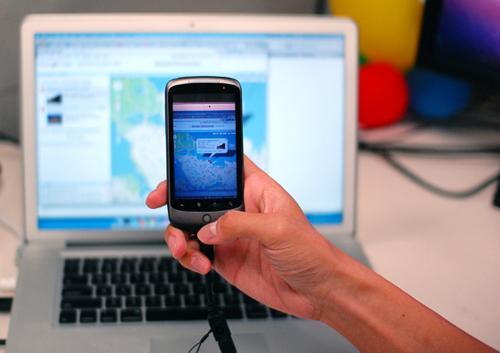
As the functionality of smartphones expands and they begin to take over some of the roles of the home computer, the need to transfer data between multiple devices is growing at an astounding rate. Currently, the only methods of transferring information between a mobile device and PC is by way of archaic email, syncing a note or, if you are an Android user, by Google's Chrome to Phone service.
Although cell phones can now handle more of the workload, it isn't always ideal to use them for everything. Sure, it's easy to pull up a map or destination on your smartphone, but it is certainly easier to work with the location and route if you look at it on the larger display of a computer. After pulling it up and working the route, how do you transfer that information back to your phone though? Entering it into the phone manually – for a second time – is always an option, but usually a last resort.
MIT graduate Tsung-Hsiang Chang, however, may have found the solution during his internship at Google last summer, and it doesn't work the way one might initially think. Oddly but appropriately named Deep Shot, the service makes use of the phone's (or tablet's) camera to transfer information between two devices. Think of it like the existing barcode scanner available for iPhone and in Android Market. But instead of scanning a barcode for price comparisons, you will be scanning your computer's display to transfer information between the devices.
Much like Google's Chrome to Phone service, Deep Shot sends data from the computer to your Android phone or tablet in the blink of an eye (by making use of URIs). A rather large caveat of Chrome to Phone (as the name implies) arises when trying to send the information in the opposite direction. You will typically have to revert to one of the aforementioned methods like Evernote or email.
According to the demonstration video, Deep Shot offers a solution to the phone-to-PC transfer by identifying "the intended computer by matching the screen image as seen through the camera." Another interesting perk of Deep Shot, claims Ina Fried of All Things D, is that it doesn't require a wireless network. The description of Deep Shot is extremely vague and to be honest, I'm not quite sure how this even works. But as long as I don't have to keep using Read It Later to transition reading an article from my phone to computer, I won't ask too many questions.
I know, I know. Most of you are thinking, "Okay, this is cool, but so what? Why should we care?"
The uses for this software are limitless and it changes the idea of how we should/can use mobile point-and-shoot cameras. Instead of just capturing that Kodak moment, your camera could be used for sharing and transferring information much more quickly and effortlessly, streamlining your use between multiple devices. Think of it as NFC ... but you're using the camera instead of NFC technology. Excluding smartphones without cameras, this will work with all current phones, an obvious plus in the defense of Deep Shot.
Google currently has rights to the software and MIT says they are unsure what El Goog plans to do with Deep Shot. Hopes that it could eventually end up being open sourced – which could lead to a plethora of apps and uses – aren't dead quite yet.
Regardless of what method you use (cloud services, NFC, Deep Shot, etc.), the future is destined to be wireless and streamlined. What say you, pups? Is this the future of transferring data between multiple devices or will NFC eradicate Deep Shot it before it ever hits consumer hands? Where could you see Deep Shot being useful or advantageous?